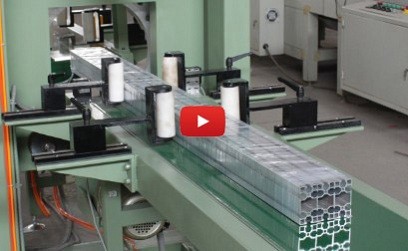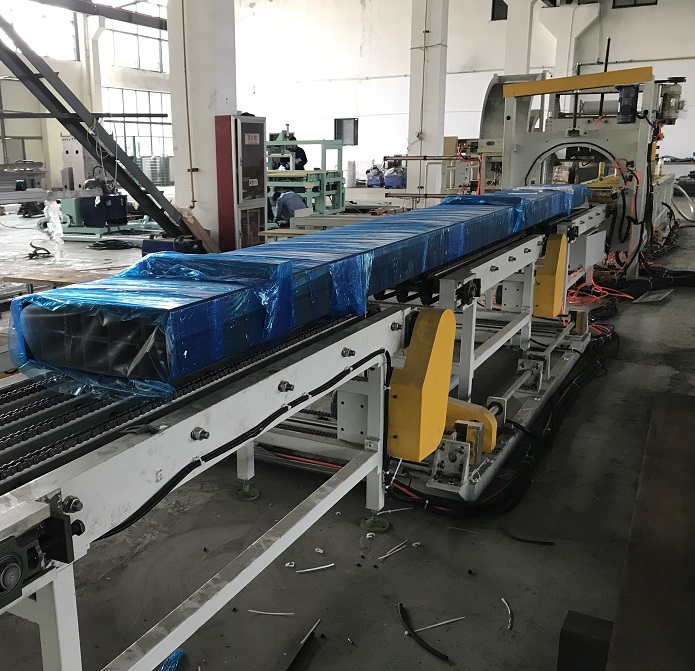Optimizing Aluminum Profile Packaging: A Guide to Spiral Stretch Wrapping Solutions
Aluminum extrusions, whether mill-finish or surface-treated, require careful handling and packaging to prevent damage during storage and transit. Their length and potential for surface scratching make packaging a critical step in the supply chain. Aluminum profile spiral stretch packing offers an effective and efficient method for protecting these valuable products. This guide explores the technology, benefits, and considerations involved in implementing spiral stretch wrapping systems for aluminum profiles.
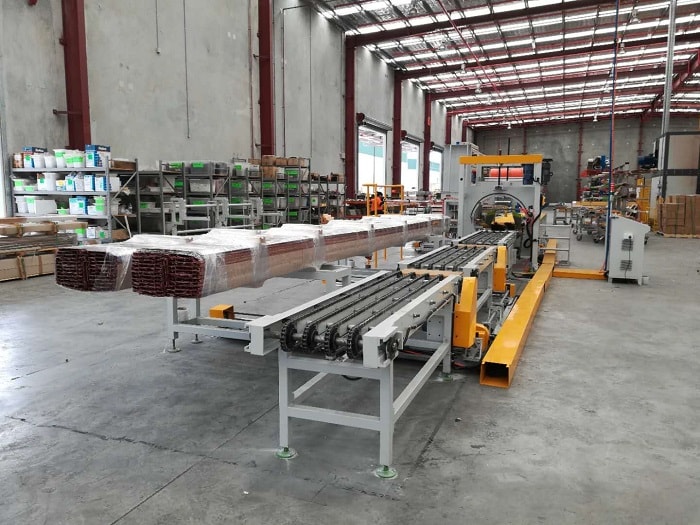
What is Aluminum Profile Spiral Stretch Wrapping?
Spiral stretch wrapping for aluminum profiles typically utilizes a horizontal orbital wrapping machine. Unlike traditional pallet wrappers that rotate the load, these machines pass the elongated aluminum profiles (often bundled) horizontally through a rotating ring carrying a roll of stretch film. The film is dispensed and wrapped spirally around the length of the bundle, creating a tight, protective layer.
(For examples of horizontal wrapping machine configurations, see details here)
Key Components and Features of a Wrapping System
A comprehensive aluminum profile packing line incorporating spiral stretch wrapping often includes several key components:
- Infeed Conveyor: Transports individual profiles or pre-assembled bundles to the wrapping station. Roller conveyors are common.
- Batching/Bundling Station: Allows operators or automated systems to assemble profiles into the desired bundle size and configuration before wrapping. Manual or automated end strapping might be applied here to initially secure the bundle.
- Spiral Wrapping Machine: The core of the system.
- Rotating Ring: Holds and rotates the film roll dispenser around the profile bundle.
- Film Carriage: Contains the stretch film roll and often includes a pre-stretch mechanism to maximize film efficiency and load containment. Systems should accommodate standard paper or plastic film rolls.
- Automatic Centering: Guides on the infeed ensure the bundle is centered relative to the wrapping ring for consistent results.
- Clamping, Cutting, and Sealing Unit: Automatically clamps the film at the start, cuts it upon cycle completion, and often seals the tail to the bundle.
- Outfeed Conveyor: Moves the wrapped bundle away from the machine, potentially towards further packaging steps.
- Control System: Typically PLC-based, allowing adjustment of wrapping parameters (rotation speed, film overlap, tension) and integration with upstream/downstream equipment.
- Optional Modules: Depending on requirements, lines can include automatic timber feeding for base boards, cardboard box forming/closing (for masterpacks), paper interleaving applicators, or integrated strapping units for final bundle securing.
The Wrapping Process Explained
- Loading & Infeed: Profiles are loaded onto the infeed conveyor, either individually or as a pre-formed bundle.
- Batching (if applicable): Profiles are grouped into the desired bundle size on a batching table. Initial strapping may occur here.
- Transfer: The bundle is transferred onto the wrapping machine's conveyor.
- Wrapping: The bundle moves horizontally through the machine. The rotating ring applies stretch film spirally along its length. The machine automatically clamps, wraps, cuts, and seals the film.
- Outfeed: The fully wrapped bundle exits the machine onto the outfeed conveyor.
- Further Processing (if applicable): The bundle may proceed to stations for adding wooden base boards, outer strapping, or insertion into a masterpack carton/crate.
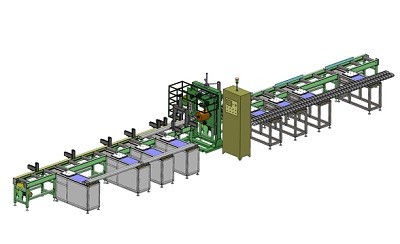
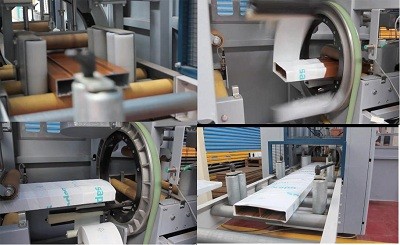
Benefits of Spiral Stretch Wrapping for Aluminum Profiles
Implementing spiral stretch wrapping offers significant advantages:
- Superior Surface Protection: The tight film layer shields sensitive mill-finish and coated surfaces from scratches, dust, moisture, and contamination.
- Bundle Stability: Securely unitizes multiple profiles, preventing shifting and potential damage during handling and transport.
- Enhanced Handling & Logistics: Wrapped bundles are easier and safer to handle, stack, and store.
- Material Efficiency: Stretch film provides high tensile strength and puncture resistance with minimal material usage, especially when pre-stretch systems are employed.
- Automation & Labor Savings: Automated lines significantly reduce manual handling requirements, improving consistency and throughput while lowering labor costs.
- Flexibility: Systems can be adapted to handle various profile shapes, sizes, and bundle configurations.
Key Considerations When Specifying a System
Selecting the right aluminum profile packing solution requires careful consideration of several factors:
- Profile Dimensions: Define the minimum and maximum length (e.g., 2m to 8m, or even up to 14m), width, and height envelope (e.g., 350mm W x 200mm H) the system must accommodate.
- Profile Weight: Specify the maximum weight per linear meter (e.g., up to 15 kg/m) and the total bundle weight.
- Required Throughput: Determine the necessary processing capacity, often measured in tons per day or bundles per hour (e.g., capable of managing 35+ tons daily across multiple lines).
- Packaging Styles: Define the required packaging formats:
- Spiral wrap only.
- Commercial bundle: Spiral wrapped, placed on a wooden base board, and secured with outer strapping.
- Masterpack: Profiles potentially interleaved with paper, placed on a wood base or in a crate, enclosed in a cardboard outer box, and strapped (may not require individual spiral wrapping).
- Finish Type: Surface-treated profiles may require gentler handling or specific film types compared to mill-finish items.
- Level of Automation: Decide between semi-automatic or fully automated lines based on volume, labor availability, and budget.
- Integration: Consider how the packing line will integrate with existing extrusion, finishing, or warehousing operations.
- Safety Features: Ensure the machinery includes necessary guarding, emergency stops, and safety interlocks compliant with industry standards.
Maintaining Efficiency and Quality
To ensure long-term performance and optimal packaging quality:
- Regular Maintenance: Follow the manufacturer's recommended maintenance schedule for mechanical components, sensors, and cutting/sealing units.
- Operator Training: Ensure personnel are properly trained on machine operation, parameter adjustments (like film tension and overlap), and safety procedures.
- Film Selection: Use high-quality stretch film appropriate for the application (LLDPE is common). Consider factors like gauge (thickness), pre-stretch capability, and puncture resistance.
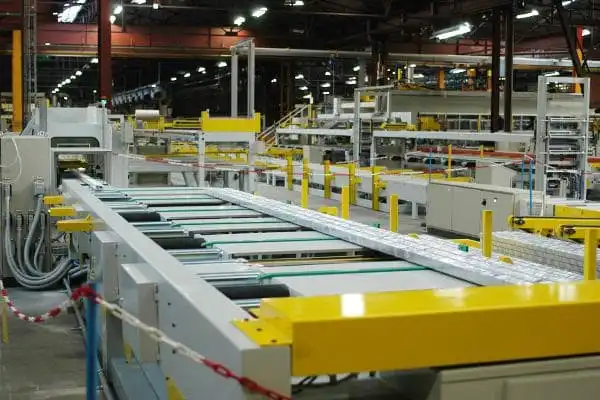
aluminum profile paper covering machine Conclusion
Effective packaging is non-negotiable for protecting the quality and integrity of aluminum profiles. Spiral stretch wrapping technology provides a robust, efficient, and adaptable solution for unitizing and safeguarding extrusions from the plant to the end-user. By carefully considering profile characteristics, throughput requirements, and desired packaging styles, manufacturers can implement automated packing lines that enhance product protection, streamline logistics, and reduce overall costs.
